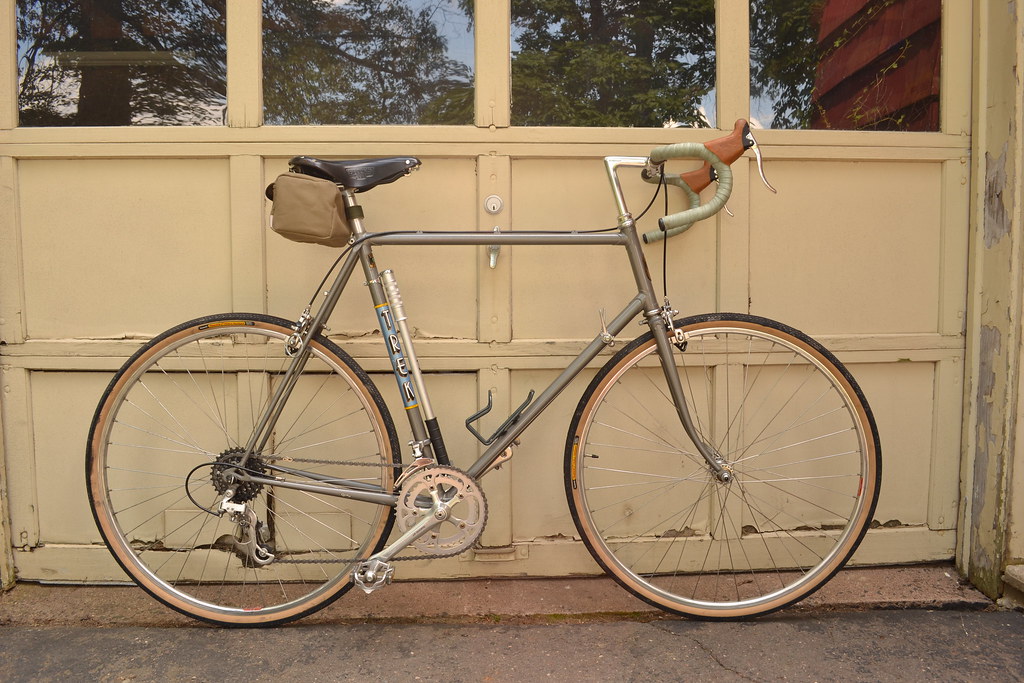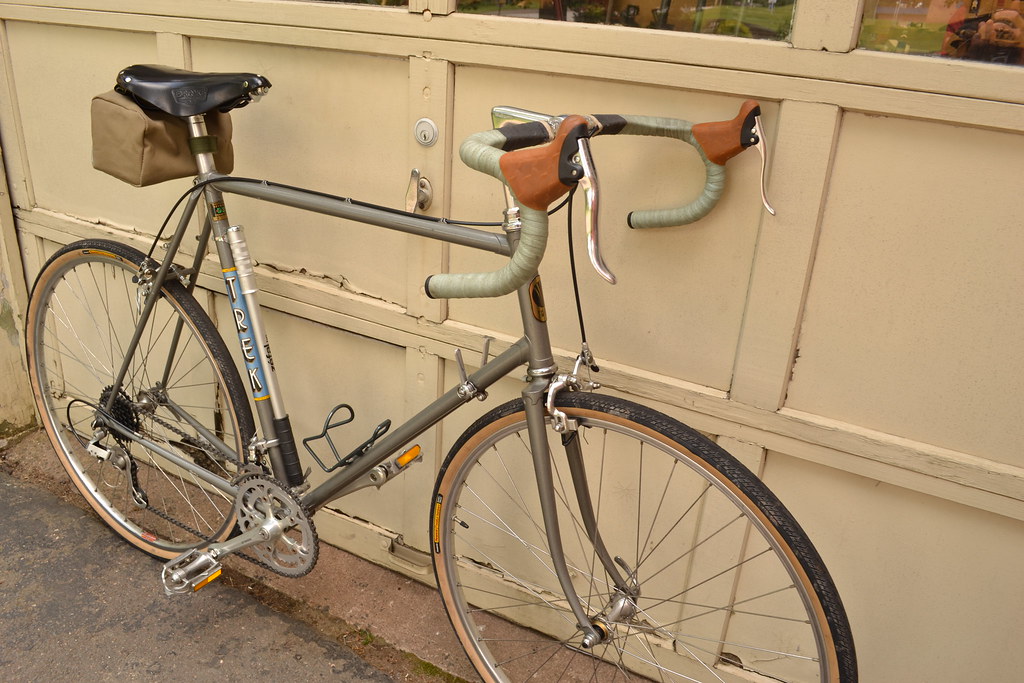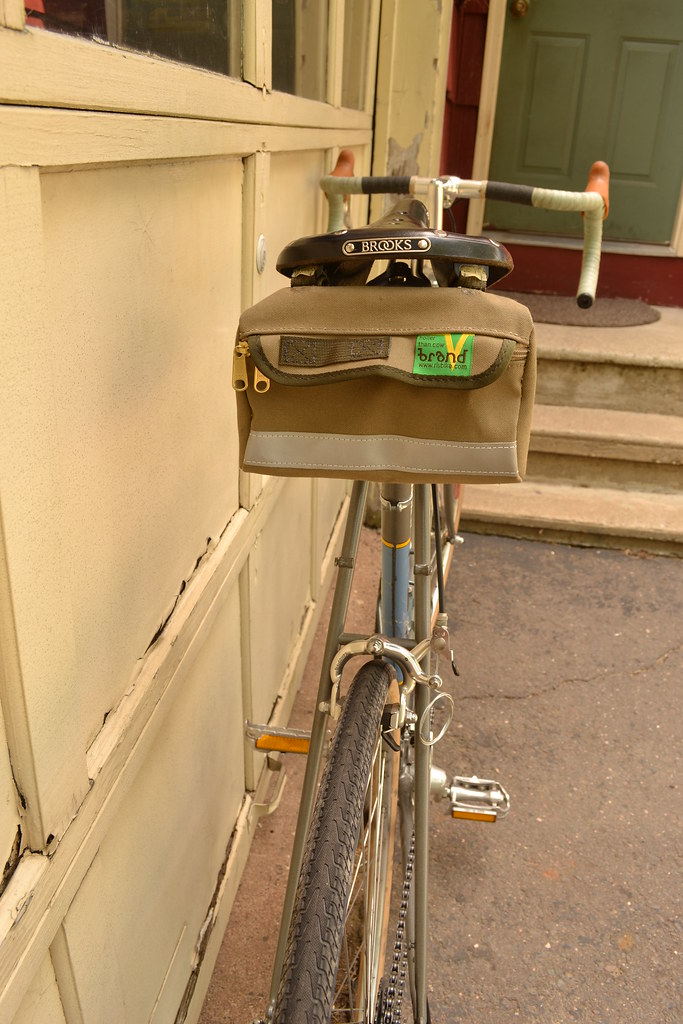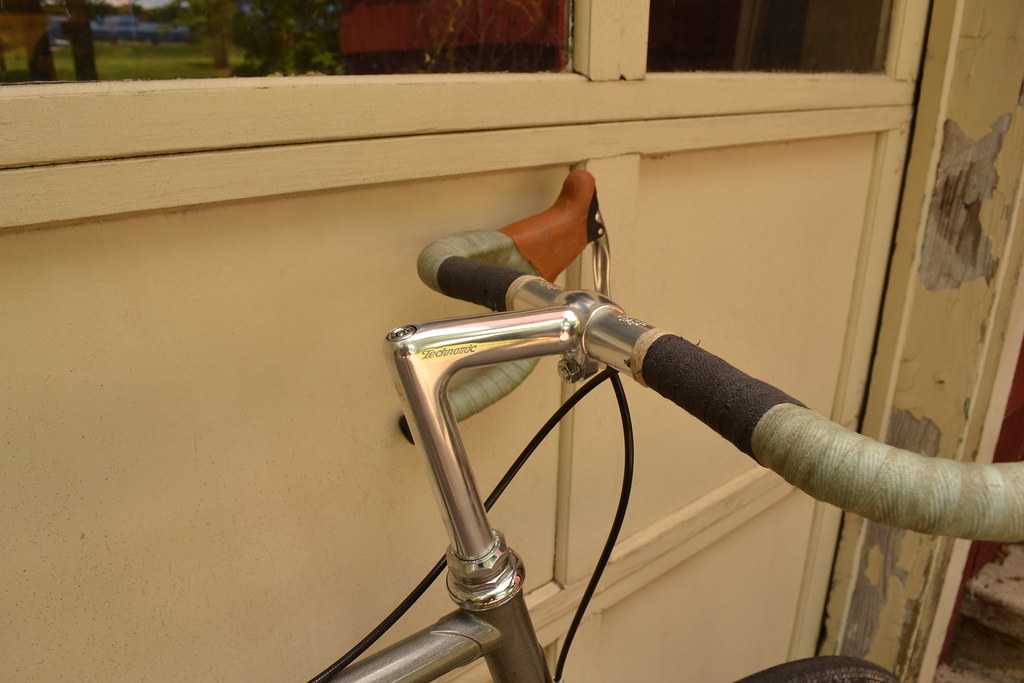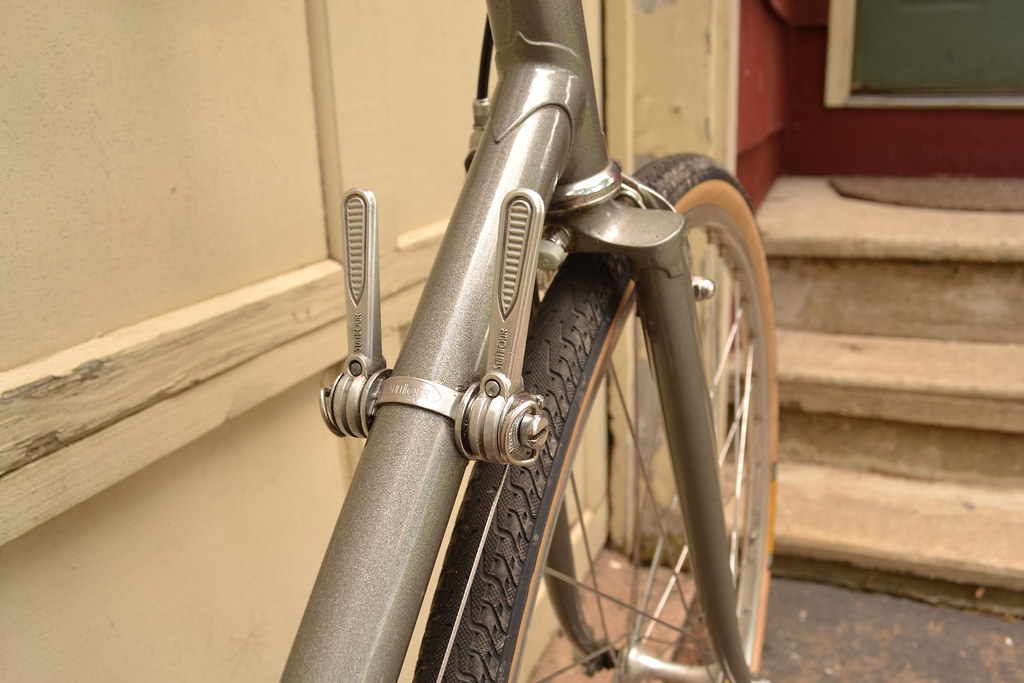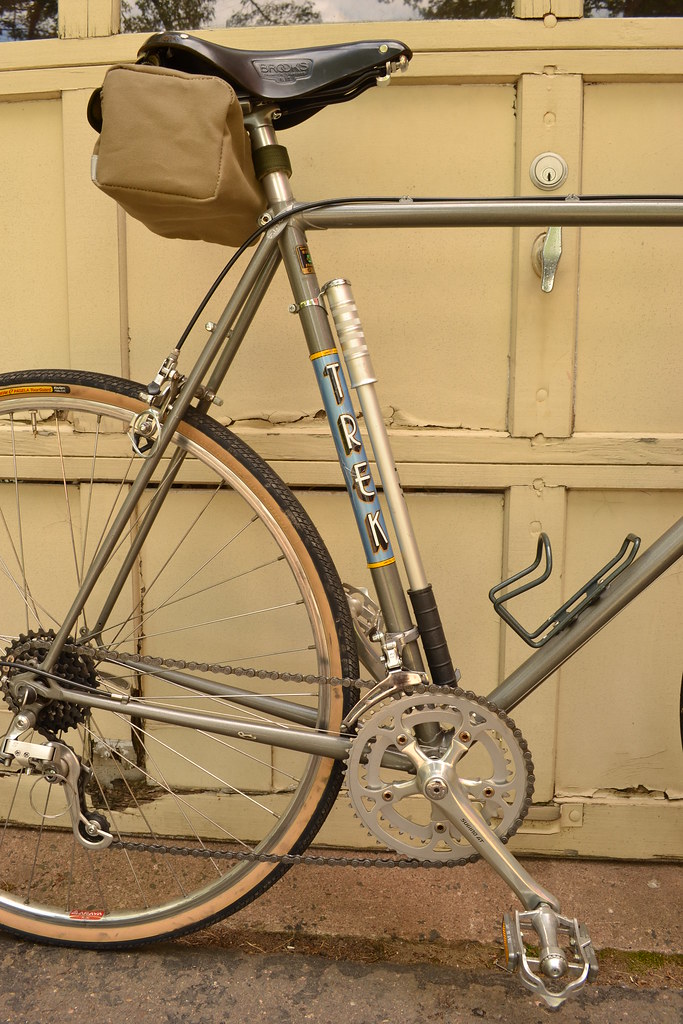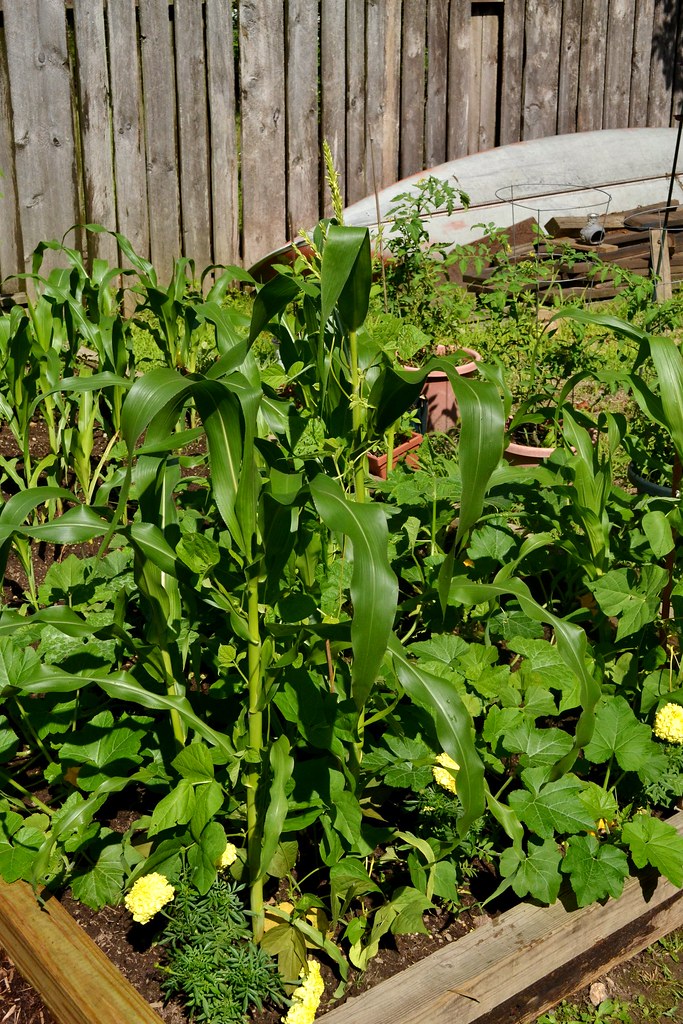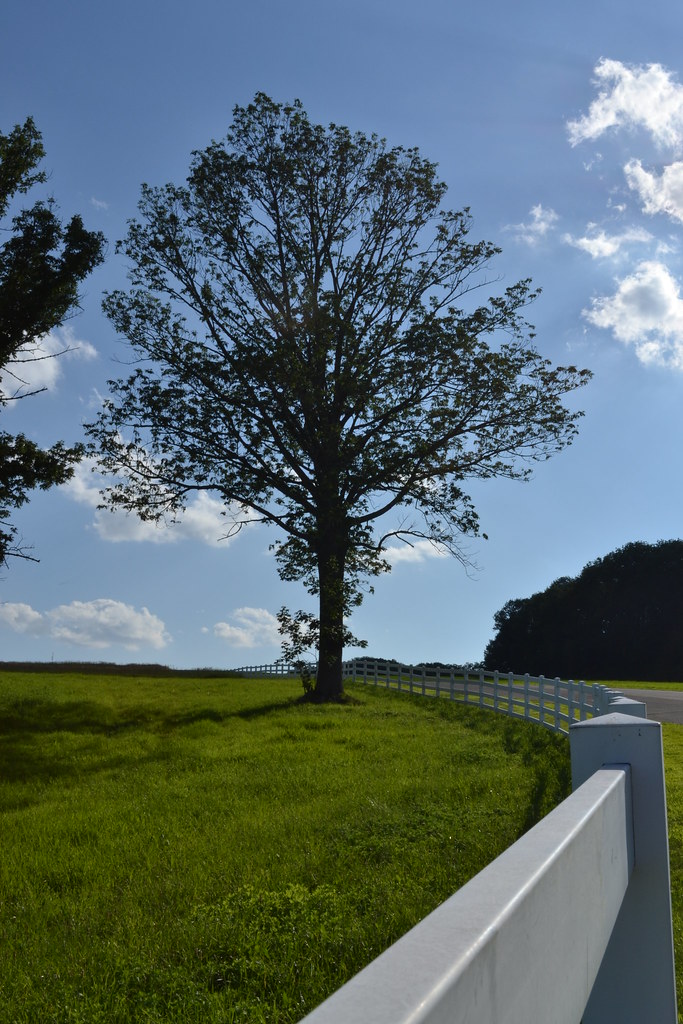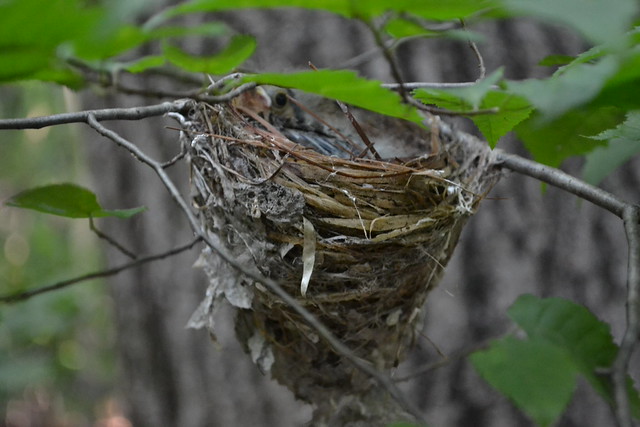About a year ago, I scored a 1982 Trek 613 bicycle of the local craigslist. These early Treks are pretty desirable and known for their quality construction and all-around practical geometry. Trek was one of the first high quality, large quantity, steel frame manufacturers in the USA, base out of Waterloo, Wisconsin. When I saw this listed locally, clearly in my size, I jumped on it. Probably one of the better deals I've ever gotten since I got into this bike thing.
What it looked like when I brought it home.
Overall is was in really nice shape, but as with most things of this nature, it needed an overhaul. I tore it down, cleaned and repacked all the bearings with grease, cleaned and adjusted all the derailleurs and brakes and outfitted her with new cable, tires and the like keeping it in pretty much original condition. I rode it in this iteration for a little while, but I had other, somewhat more practical bikes at the time which saw most of the riding duty. The Trek hung on the rack and looked pretty until I felt like taking the "vintage bike" for a spin.
I've long since admired many of the ideals pushed by Grant Petersen and Rivendell Bicycle Works, as controversial as they may be. I will likely never be willing/able to dish out the dough required for one of their bikes, but I think they have the right idea about what cycling ought to be for many people and they have an awful lot of cool and very practical parts for sale. When I decided to refit the Trek with some new parts I drew a lot of influence from Rivendell and the sort of randonneur inspired subculture that's currently gaining a lot of support in the cycling community.
But what does all this mean? I wanted to be able to ride my bike long distances, on asphalt, dirt, or any other possible conditions, and be comfortable doing so. Large tires, sensible gearing, raised handlebars and a comfortable leather saddle all play a role. So here is the refinished and re-thought Trek 613.
The frame itself is constructed of Reynolds 531 double-butted chromoly tubing, a legendary tube-set in the world of classic steel bicycles. The chainstays and fork are made of Ishiwata manganese steel tubing. The geometry is very comfortable but lively all around. It's a good compromise of laid back, and steep racing geometry with decent tire clearance. It's got 73 degree head and seat-tube angles and 44cm stays.
I decided to go with a 700c wheel size rather than the original 27" because of the greater availability of tires in 700c sizes. The Panaracer Pasela is a fantastic tire for the money, here I went with the Tourguard version that has kevlar reinforcement for better flat protection. I wanted to go with the fattest tire I could and still have room for fenders, so I went with 700 x 32mm. They actually measure about 30mm wide and I run them at around 85psi for good shock absorbency.
The saddle is the classic Brooks B-17, another craigslist score. This high quality British leather saddle has been largely the same since the turn of the nineteenth century and has long since been the choice for tourists and all sorts of other riders. The key is the leather, they say it breaks into your "sit-bones", and it has earned the B-17 it's famed comfort. I though it was pretty comfortable right out of the box. This saddle bag was an ebay score, made in Connecticut even, it holds my tools/spares real good, and looks pretty nice too.
Another key component to the rethinking of this bike was to raise the handlebars up a bit. If your racing and trying to be as aerodynamic as possible, being hunched down real low is what you want, not so much in my interest though. The Nitto Technomic stem is super long and allows me to raise my handlebars up to where the tops of the bars are lever with the saddle. This makes all the riding positions much more comfortable. The handlebars are a 44cm wide version of the Grant-designed Nitto Model 177, also known as the Noodle, and it's quickly becoming my favorite bar ever. Newbaum's cotton bar-tape shellacked for a durable finish, and Tektro aero brake lever with Cane Creek gum-colored hoods. I dyed the hoods a bit with brown shoe polish to darken them up a bit, I think they came out great.
The derailleurs came off of an '85 Cannondale touring bike that I got for a song on craigslist. I sold the frame and wheelset to offset the cost of the bike and I got a bunch of cool parts to keep. These Suntour Superbe Pro derailleurs were part of the kit. The rear is a long cage version and it seems to be a rare bird. There's not much info out there about this particular derailleur, but I can say for sure that it shifts like a dream.
The cranks came to me in a trade with a forum member for the same crankset in a shorter lenght. These are 17mm Sugino AT cranks, currently set up as a double with 38-48 gearing. I can put a granny gear on if I so choose.. I'm still sort of playing around with gearing. Sometimes I find myself feeling like I's benefit from a 175mm crank, but who knows, these are working great for the time being.
Suntour VX shifters, because friction shifting is cool. Working on getting some Suntour barcons, because I like them a little bit better. Easier access and better hold on rough roads.
Frame-mounted Zefal pump for flats and style points.
Overall, I'm super pleased. The thing rides awesome, and it does pretty much everything I want it to do. I'm still doing a little bit of tweaking, and really when are these projects ever truly "finished." I'll update about it as I ride more and make additions/changes.
Wednesday, July 20, 2011
Thursday, July 14, 2011
Beer..
There has been quite a bit of talk about Dogfish Head recently, and the conversation I just had with one of the local package store owner's made me decide to post about it. For those of you not in the know, Dogfish Head is a craft brewery based out of Delaware and have been renowned for there quality brews among the craft beer community for years. Recently, Sam Calagione owner of Dogfish Head, took to the airwaves on a Discovery series called Brew Masters and as a result has gained a tremendous interest by the mainstream. Sometime thereafter, they started distributing nationwide or at least in more states than they had been, and as a result they have not been able to keep up on supply. Now many stores can't get any cases of any of Dogfish's beers, and when they do it often flies off the shelf. Distributors simply don't have any in stock, and getting it is difficult because of this increase in demand. Sam posted this on the website himself addressing the lack of Dogfish Head beer across the nation. I work in another local package store and people come in all the time asking for "dog-head fish?" and I have to tell them an abreviated version of what I just told you, and then I get to point them to the Lagunitas.
On the upside of all this, some breweries are treated to shelf space once reserved for Dogfish Head. As many of the craft beer drinkers out there know, there is a staggering number of quality beer out there coming out of all states and breweries of all shapes and sizes, and purchases are made on seasonality, freshness, and what you're in the mood for rather than whats on TV. Like more than a couple of local stores that I've seen, the store that I work for has filled in the empty shelf space with a few beers from Lagunitas Brewing Company out of Petaluma, California. They turn out some really quality beers and here on the east coast, you don't see their product too often, so I see this as a perfect opportunity to turn people on to another solid brewery. I had pizza tonight and decided to bring their Pale Ale.
The Lagunitas (say Lah-Goo-Knee-Tas) Pale Ale is one of those pale ales that is pretty much an IPA, just the less volatile IPA being made by that brewery, in fact it is what sometimes called an American Pale Ale. This often seems to be the case especially with California beers (think Sierra Nevada & Stone), but how could it be any way with so many fantastic American hop varieties being grown so locally. The aroma and the taste are both big on the hops in this beer, but subtle enough to be very drinkable and go well with food. It's very dry and the hop bitterness is backed by light, biscuity pale malt flavors. A good drinking beer for hop-heads, and quite accessible to those new to beers on this end of the spectrum. I recommend this one if you want to try something new.
On the upside of all this, some breweries are treated to shelf space once reserved for Dogfish Head. As many of the craft beer drinkers out there know, there is a staggering number of quality beer out there coming out of all states and breweries of all shapes and sizes, and purchases are made on seasonality, freshness, and what you're in the mood for rather than whats on TV. Like more than a couple of local stores that I've seen, the store that I work for has filled in the empty shelf space with a few beers from Lagunitas Brewing Company out of Petaluma, California. They turn out some really quality beers and here on the east coast, you don't see their product too often, so I see this as a perfect opportunity to turn people on to another solid brewery. I had pizza tonight and decided to bring their Pale Ale.
The Lagunitas (say Lah-Goo-Knee-Tas) Pale Ale is one of those pale ales that is pretty much an IPA, just the less volatile IPA being made by that brewery, in fact it is what sometimes called an American Pale Ale. This often seems to be the case especially with California beers (think Sierra Nevada & Stone), but how could it be any way with so many fantastic American hop varieties being grown so locally. The aroma and the taste are both big on the hops in this beer, but subtle enough to be very drinkable and go well with food. It's very dry and the hop bitterness is backed by light, biscuity pale malt flavors. A good drinking beer for hop-heads, and quite accessible to those new to beers on this end of the spectrum. I recommend this one if you want to try something new.
Sunday, July 10, 2011
Three Sisters Garden
Well, the last time I posted about my garden experiment it was just a bunch of dirt, since then I've planted some stuff. The main attraction of the garden is the interplanted corn, beans & squash as described in my Garden pH post back in may. Just for good measure I'll recap..
This spring I took an archeology class and I learned that many early North American cultures interplanted corn, beans and squash in a system known as the "three sisters." The corn provides storable carbohydrates and a structure for the beans to climb, the beans are nitrogen fixing and supplement protein, and the squash provides weed control by covering the ground. I thought this was pretty cool and decided I wanted to give it a shot, this was the real motivating factor behind getting this garden built. I don't expect tremendous yields, I guess it's more an experiment than anything, but we'll see.
The section of the garden hosting the three sisters is 5' x 9' with 18 mounds each a little over a foot in diameter. Half the mounds have corn & beans, the other half squash, and they alternate accordingly. Each of the corn/beans mounds have four corn plants with a bean plant for each stalk. The squash mounds also hold four plants. I staggered my planting in three stages, each a few weeks apart, so I don't harvest everything all at once.
The corn is a hybrid sweet corn called golden cross, and they say it's pretty delicious. I chose it because it's supposed to be pretty reliable in a variety of conditions. The beans are a mixed variety of pole beans called Kentucky Wonder, an heirloom variety first introduced by 1864 and originally known as old homestead. This variety quickly became popular for it's unusually long beans, and still today it's one of the most common pole beans available. The squash is primarily a variety called Delicata. It's a heirloom squash, also known as sweet potato squash for it's flavor. It's skin is fairly thin, from what I've read, so it's difficult to ship and thus not commonly available at the grocery store. In one of the squash mounds I planted three cucumber plants that I got from my uncle, the voracious vines of which are taking over the 4 foot radius around the mound. Damn thing almost took down one of my corn plants, I didn't realize they were so vine-y. Speaking of heirloom vegetables, as trendy as it may seem, reminds me of a very interesting article I read in this months National Geographic, seen here..http://ngm.nationalgeographic.com/2011/07/food-ark/siebert-text
Ive got some other stuff planted but I'll save that for later. For now, I'll get on with the pictures.
This is a shot of my prize corn plant about a week and a half ago.
And more currently..
The squash has grown considerably and is finally doing it's job as ground cover for weed control. I've planted some Marigolds to try and deter the bugs.
This spring I took an archeology class and I learned that many early North American cultures interplanted corn, beans and squash in a system known as the "three sisters." The corn provides storable carbohydrates and a structure for the beans to climb, the beans are nitrogen fixing and supplement protein, and the squash provides weed control by covering the ground. I thought this was pretty cool and decided I wanted to give it a shot, this was the real motivating factor behind getting this garden built. I don't expect tremendous yields, I guess it's more an experiment than anything, but we'll see.
The section of the garden hosting the three sisters is 5' x 9' with 18 mounds each a little over a foot in diameter. Half the mounds have corn & beans, the other half squash, and they alternate accordingly. Each of the corn/beans mounds have four corn plants with a bean plant for each stalk. The squash mounds also hold four plants. I staggered my planting in three stages, each a few weeks apart, so I don't harvest everything all at once.
The corn is a hybrid sweet corn called golden cross, and they say it's pretty delicious. I chose it because it's supposed to be pretty reliable in a variety of conditions. The beans are a mixed variety of pole beans called Kentucky Wonder, an heirloom variety first introduced by 1864 and originally known as old homestead. This variety quickly became popular for it's unusually long beans, and still today it's one of the most common pole beans available. The squash is primarily a variety called Delicata. It's a heirloom squash, also known as sweet potato squash for it's flavor. It's skin is fairly thin, from what I've read, so it's difficult to ship and thus not commonly available at the grocery store. In one of the squash mounds I planted three cucumber plants that I got from my uncle, the voracious vines of which are taking over the 4 foot radius around the mound. Damn thing almost took down one of my corn plants, I didn't realize they were so vine-y. Speaking of heirloom vegetables, as trendy as it may seem, reminds me of a very interesting article I read in this months National Geographic, seen here..http://ngm.nationalgeographic.com/2011/07/food-ark/siebert-text
Ive got some other stuff planted but I'll save that for later. For now, I'll get on with the pictures.
This is a shot of my prize corn plant about a week and a half ago.
And more currently..
The squash has grown considerably and is finally doing it's job as ground cover for weed control. I've planted some Marigolds to try and deter the bugs.
Saturday, July 2, 2011
Horsebarn Hill
So Hadlai and I have been hanging around Horsebarn Hill, one of the major agricultural areas on the Uconn campus. The hill itself is in sight of the world famous Uconn Dairy Bar, which I highly recommend that you check out should you ever find yourself in the Storrs region. On our first outing, Hadlai got some real nice shots of the Holsteins and some farm equipment, a tractor in particular, but I can't find the pictures... I'll be sure to post them when I do.
Yesterday we went for a walk on some of the trails in the area, connecting what's known as the Uconn forest to the Nipmuck Trail, one of Connecticuts blue blaze trails, and some other surrounding areas. It was a real nice walk and there's plenty of exploration opportunities, but we got eaten alive by mosquitoes and ended up having to walk on the road from pretty far away.
Yesterday we went for a walk on some of the trails in the area, connecting what's known as the Uconn forest to the Nipmuck Trail, one of Connecticuts blue blaze trails, and some other surrounding areas. It was a real nice walk and there's plenty of exploration opportunities, but we got eaten alive by mosquitoes and ended up having to walk on the road from pretty far away.
We stumbled across this nest right in a tree branch, there was a bird in it too. Unfortunately for me it was a bit out of my reach and this was the best shot I could get of the baby bird.
Subscribe to:
Posts (Atom)

